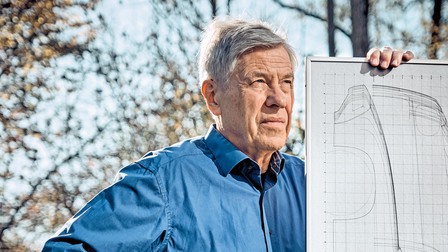
Porsche Takes the Plunge
Looking it up: The type plate of the
Spring of 1977:
“You cannot discover new lands without consenting to lose sight of the shore for a very long time,” said André Gide, French writer and 1947 winner of the Nobel Prize in Literature. Although Gide could not have known it, his quote beautifully captures the mood at
Ernst Fuhrmann, the new chairman of the executive board, favored a novel model concept—a radical renunciation of the rear-engine principle. He envisioned a sports car with the engine mounted in the front and the transmission in the rear, connected by something called a “fast shaft.” This distribution of the drive system components is known as a transaxle construction, and it was to be a defining feature of the
The decision was daring, given
![[+]](https://staging.www.porsche.com/filestore/image/multimedia/none/christophorus-issue384-article02-content-01/normal/e3b18e6a-c524-11e7-b591-0019999cd470/porsche-normal.jpg)
Taking it out: Andrew Phinney first discovered his
Bumpers hardly seem radical today but, at the time, they brought the engineers, designers, and of course project director Gorissen to the brink of despair. It wasn’t just a matter of their complex, elastic mount. In particular, the paint job presented a challenge. “At that time, we simply didn’t have a paint that could cover steel, aluminum, and polyurethane equally well,” Gorissen recalls. “There were different shades wherever you looked.” The right paint for the job had yet to be invented—and it was, just in time for the series production.
While engineers were working on hundreds of little details in their quest to gain every possible centimeter and lose every possible kilogram, experts from the testing department were taking each successive prototype to its physical limits. The nearly ideal 50:50 weight distribution between the front and rear axles, the large-volume V8 engine, and the sophisticated suspension created expectations of first-class performance, at least on paper. But the 928 actually outstripped all expectations. Gorissen recalls those nighttime test-drives in the Black Forest very clearly: “It was winter. Some of the roads were icy, and it looked like a real challenge.” But the drivers climbed out of the car as cheery as could be after their excursion. “The car drove a full class better than the 911 of that time.”
The 928 was something different right from the start. Above all, it was positioned higher on the market—as a sporty touring car, or
![[+]](https://staging.www.porsche.com/filestore/image/multimedia/none/christophorus-issue384-article02-content-02/normal/ea751877-c524-11e7-b591-0019999cd470/porsche-normal.jpg)
Masterpiece: A large-volume, water-cooled, 4.5-liter V8 engine is the
The 928 seemed to glide rather than roll on the road. It generated significantly less noise than the air-cooled engine of the 911. It handled much more agreeably and offered outstanding comfort: The air-conditioning system cooled the glove compartment; the height of the steering wheel and seats could be adjusted; and drivers could also adjust their pedal positions, foot rest, and gear shift. The windshield wipers had a separate tank with a dedicated dosage pump that sprayed a special cleaning agent onto the window from time to time to keep the glass free of streaks. And finally, the car had a specially designed “
The 928’s world debut at the Geneva Motor Show in March of 1977 was a sensation, and the public was thrilled. According to Der Spiegel, “Former Volkswagen head Rudolf Leiding bought one at once—for his wife.” The magazine also noted, “No other car has played a more crucial role in
But events turned out differently, as we now know, forty years on, even though the
Lagaaij has never stopped admiring the car’s design language. At some point in the conversation about its timelessly elegant aesthetics and coherent concept, he says something that seems to echo the words of André Gide: “The 928 was like a new continent in the
By Sven Freese
Photos by Christian Grund, Ty Milford
Andrew Phinney
The fifty-one-year-old from Connecticut is the proud owner of the first
“As a teen, I would sit in front of the TV set, which is where I first encountered a
Hans Clausecker
Born in 1940, Clausecker became a suspension expert and joined the 928 development team shortly before the car’s premiere. He was involved in testing winter tires—and in making the only factory race car of this model type.
“I joined the testing team about a year before the 928 was introduced. We were focusing on winter tires and running tests in Austria near the Turracher Höhe Pass and on frozen Lake Falkertsee near Bad Kleinkirchheim. To see how it handled, we drove to the Nürburgring or the Contidrom near Hanover. Thanks to its nearly ideal weight distribution, the 928 was much less problematic to drive than the 911. I thought it was extremely good-natured and found it to be a wonderfully comfortable touring car. My colleague Günter Steckkönig and I both thought this car would be an ideal candidate for the European Touring Car Championship. As a matter of fact, we received authorization to proceed; the 928 was ready to go in 1983. It did well at the Veedol Endurance Race on the Nürburgring and at the 24 Hours of Daytona as well. But unfortunately, it didn’t meet the requirement for the European Touring Car Championship of five thousand production cars sold in a year. That put an end to the dream of a racing career for the 928. More than thirty years went by before the 928 race car was resuscitated by
Hans-Georg Kasten
After studying design and automotive body construction in Hamburg, Kasten promptly joined
“I joined Style
![[+]](https://staging.www.porsche.com/filestore/image/multimedia/none/christophorus-issue384-article02-margin-01/normal/f333f31b-c524-11e7-b591-0019999cd470/porsche-normal.jpg)
![[+]](https://staging.www.porsche.com/filestore/image/multimedia/none/christophorus-issue384-article02-margin-02/normal/f333f31c-c524-11e7-b591-0019999cd470/porsche-normal.jpg)
![[+]](https://staging.www.porsche.com/filestore/image/multimedia/none/christophorus-issue384-article02-margin-03/normal/0336f53e-c525-11e7-b591-0019999cd470/porsche-normal.jpg)
![[+]](https://staging.www.porsche.com/filestore/image/multimedia/none/christophorus-issue384-article02-margin-04/normal/3b960a27-c525-11e7-b591-0019999cd470/porsche-normal.jpg)
![[+]](https://staging.www.porsche.com/filestore/image/multimedia/none/christophorus-issue384-article02-margin-05/normal/3b960a28-c525-11e7-b591-0019999cd470/porsche-normal.jpg)
![[+]](https://staging.www.porsche.com/filestore/image/multimedia/none/christophorus-issue384-article02-margin-06/normal/45a71a85-c525-11e7-b591-0019999cd470/porsche-normal.jpg)








